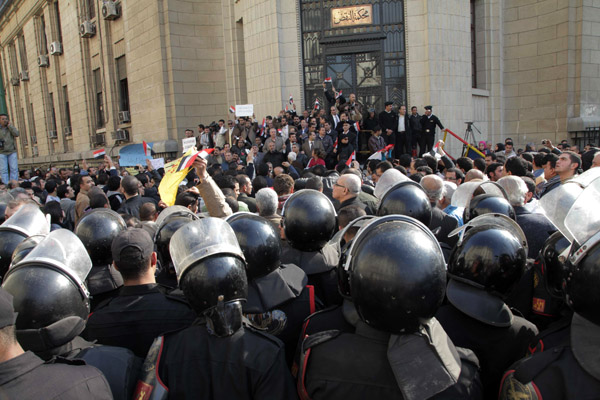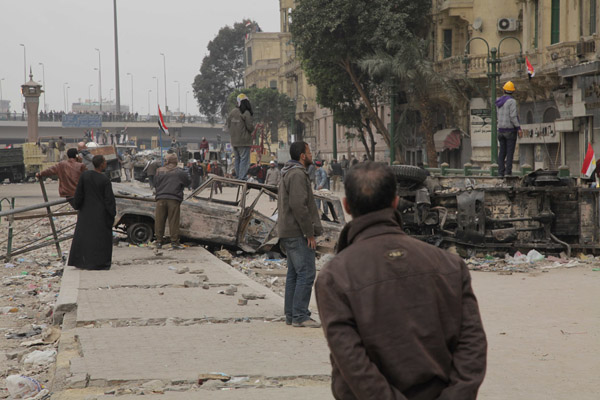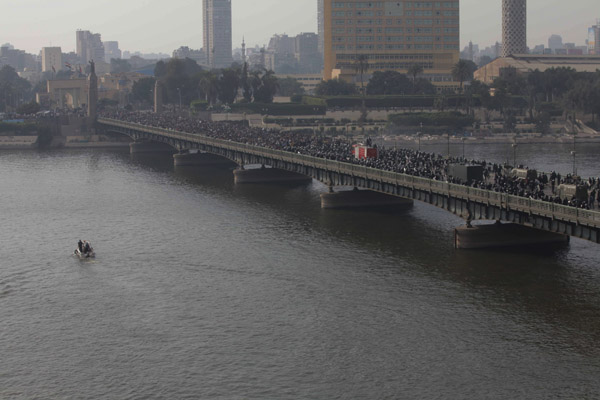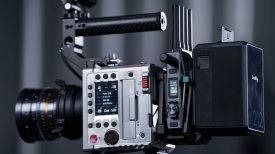By Duncan Sharp
Egyption Revolution – Duncan Sharp Sky News from duncan sharp on Vimeo.
This was supposed to have been a one-day wonder: a knock-on protest following the success of the uprising in Tunis a week earlier. We planned a quick “in and out” to cover the demonstration in the Egyptian capital. Instead, this first protest lit the fuse that ignited two weeks of sustained street violence that toppled the Mubarak government and left 140 crew members and journalists injured and an Egyptian reporter dead.
Cairo seemed calm that morning before the crowds began to gather. There was a heightened police presence on the streets but nothing overwhelming. We didn’t know where the protests were going to occur, but we knew the plan was to march to Tahrir Square. So we hooked up with one group and stuck with them down to the Square. There wasn’t much aggression – lots of shouting and chanting but certainly no violence. The police presence was pretty low-key. I certainly didn’t feel threatened and was moving between the police and the protestors, getting pictures from both sides. I even did what you really shouldn’t and got in between the two groups. It was all fairly low risk. But that was to change. Unfortunately we had to get back to the hotel to edit a piece for 17:00 GMT. Once we had got back to the hotel and I started loading the pictures, you could hear the volleys of tear gas down in the Square.
I really wanted to go back out and get more pictures but we were locked into the feed for the 17:00 GMT, one of the most important bulletins of the day. Our hotel was overlooking the square and although I couldn’t see much I could hear that things had definitely picked up. Our flights were changed that night to come back Thursday.
Wednesday, the police presence on the streets had tripled from the day before and we had to be reasonably careful since we were on tourist visas and had no official permission to film in the country. We drove around Tahrir Square (when you could drive round it) and filmed the lines of armed police through the taxi window. Again we didn’t know where exactly these protests were going to start, only that they were aimed at getting to Tahir square. We heard rumours that there were some protests outside the press syndicate building. On arrival you could feel that tensions were mounting. It certainly didn’t have the same feel to it as Friday. I started filming behind the police as they became quite hostile hitting the protestors with long sticks and truncheons.
What started out with the police keeping protestors inside the press syndicate soon changed to them being surrounded on three fronts. This got interesting because there was really no safe place to be. As I approached a group of secret police grappling with a protestor I got grabbed, the police trying to take the camera out of my hands. I got it out of reach just in time, then I was forced through the police lines and pushed into a group of protestors. As I looked up another cameraman using a large ENG camera was having to fight for his life to stop the police taking it and smashing it on the group.
Then the secret police approached the protestors for what can only be described as a smash and grab. Watching up to 6000 protestors scatter when approached by only about 8 men was quite astonishing. Things were getting very nasty very quickly. We hurried back to the hotel to edit and just made the 17:00 bulletin. The next few days brought the most noticeable change to Cairo’s streets. Shops were shut on normal working days. The hotel we were staying at had started to board up its windows, all in preparation for Friday’s protest.
That day started off like the previous few, quiet in the morning, not much going on, but we were waiting for Friday prayers to finish, knowing that this would bring a lot of people out onto the streets. The afternoon was the turning point. Hundreds of thousands of people took to the streets and the clashes with the police were very violent, lasting for hours. Several buildings were burnt down and shops looted. Hundreds of cars were set on fire across the city.
As a television crew the most frustrating moment of the trip occurred later that day when the government cut all internet connections across the country. We had no way of sending any of the pictures back to Sky and had to wait until a BGAN sat dish was brought into the country. That didn’t happen until the following evening. Our hotel, because of its location, took quite drastic steps to keep the guests and property safe from looting and fighting. The lifts stopped going down to the lobby, they made a makeshift barricade across every entrance to the hotel and also cut the lights to the first three floors. This made leaving and re-entering the hotel nearly impossible. The next day they had even called on the chefs armed with meat cleavers to guard the lobby.
Over the next few days things calmed down a bit, but the scars still remained across the city. The next flash point and probably the most dangerous turning point during the whole revolution, was the emergence of the ‘pro-Mubarak’ protestors. For the first time protestors were actually targeting foreign journalists. This made covering the story very difficult and there were numerous reports of journalists being assaulted or killed. By this stage the world’s media were in Cairo and the internet had been restored so it was far easier to get pictures out. The Army made no attempt to try and break up the fighting between the two warring factions. They just hid in their tanks and waited for the storm to blow over.
I spent the next few days within the square, which the time was probably one of the safest places to be. The protestors had set up checkpoints and were looking for weapons and any pro-Mubarak supporters that were trying to infiltrate the square. They seemed very happy with the foreign journalists’ coverage of the events and it gave me a chance hear more from them and get some nice images.
I left Cairo a week later and as I was flying back to the UK I really thought about the kit I brought, how well the 5D mkII performed and whether I would have done things any differently. My conclusion? Probably not. What really stuck out in my mind was how well the Canon 24-105 f4.0L IS lens performed and how steady all the shots were with no Zacuto Z-finder or support rig to speak of. Recording audio separately for all interviews and pieces to camera was very much out of my comfort zone, but after using it in anger for the first few days I was really happy with the results. I highly rate the Tascam DR100 recorder – it performed very well, although I was always worried that the levels would be too low or the mic could become unplugged. Of course I would prefer onboard audio with monitoring but I found that this worked just fine. The onboard mic was fine for background sound – we all know it’s not great but it was more than adequate. The key I found to shooting these kind of events with a 5D mkII is having a lens with an image stabilizer and also stopping down the aperture as much as you can. I was in no position to start following focus, so I dialled up the ISO and was consistently shooting in the late F-stops from f11 to f22.
As a consequence of this trip, I’m now looking into the video performance of the Panasonic GH2. I find that the main issue with the 5D mkII is the time it takes to get pictures into Final Cut before you can start editing. When working under such tight deadlines it’s the difference between staying on the ground that extra hour rather than returning to the hotel early to edit. I also feel that I was regularly wanting more telephoto range on my lenses and although fast, the 70-200 f2.8 lens just doesn’t offer enough range.
I’m sure it won’t be long until I’m back in the Middle East covering another revolution, the only difference being that maybe this time it will be with the Panasonic GH2.
Duncan Sharp has been at Sky News for 7 years as a Cameraman/Editor covering stories in Afghanistan, Libya, Burna, Sri lanka, India and South Africa. He also spent a year working in the company’s Beijing Bureau. He is working on solutions to covering news that don’t involve using traditional ENG cameras.











